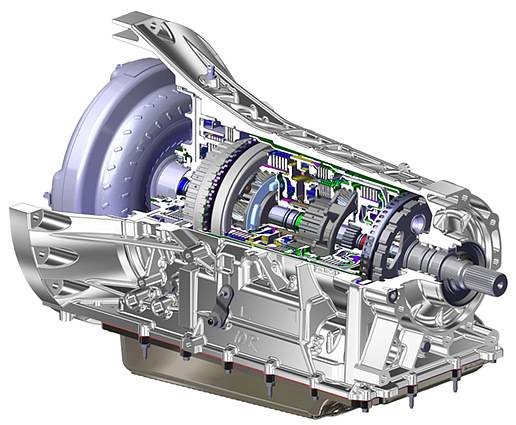 美国环保署认为,一些创新节能技术将为全美车辆燃料经济性的提升做出贡献,比如这款福特10速自动变速器(图片来源:福特)。
美国环保署认为,一些创新节能技术将为全美车辆燃料经济性的提升做出贡献,比如这款福特10速自动变速器(图片来源:福特)。
在SAE 2017高效内燃发动机研讨会(2017 SAE High-Efficiency IC Engines Symposium)上,美国环保署轻型汽车与小型发动机中心(Light-Duty Vehicle and Small-Engine Center)主任Michael Olechiw告诉在场观众,尽管特朗普政府已经表示有意回调奥巴马总统在2012年出台的雄心勃勃的公司平均燃料经济性标准(CAFE),且很多汽车制造商也突然“抛弃”了在过去5年中一直遵循的产品研发指导方针。然而,随着直喷燃料系统和高级变速器等“主流”动力系统的迅猛发展,汽车制造商很有可能在2025年前真正实现54.4 mpg(3.4L/100 km)的燃料经济性目标。
尽管,汽车行业主要游说团体曾表示,汽车厂商为实现2025年CAFE标准所需付出的成本“非常惊人”。不过,Olechiw向在场消费者展示了环保署的最新成本评估结果:对于2021到2025型号年的车型来说,采用“非常传统的技术”实现2025年CAFE目标的成本仅为每车825美元。他补充说,与此同时,选择达到CAFE标准的车型还能帮消费者节省大约1650美元的燃料支出,相当于成本的2倍。
Olechiw表示,目前,美国市场中近50%的轻型车均采用了直喷系统,其中马自达品牌车型的直喷系统配备率高达100%,其他6家大型制造商的配备率也达到了75%以上。此外,目前美国市场中采用7速以上变速器的车型占新车型总数的20%;CVT系统的配备率也差不多在20%上下。
Olechiw承认,尽管目前全美仅有5%的车型达到了2025年CAFE标准(且这些车型均为混动汽车或全电动汽车),但他并不认为消费者对重型卡车和跨界车的购买偏好,一定会让54.5mpg的终极燃料经济性目标成为泡影。根据环保署的规定,较大车型本身就允许比小型车排放更多尾气。环保署对目前的进展感到满意:“到目前为止,一切都在按计划进行。”Olechiw介绍道。
排放“额度”
Olechiw表示,自CAFE标准实施以来,汽车厂商已经累计了大约280兆克的排放额度。他解释说,厂商所有面向美国市场的车型每行驶1英里减少CO2排放80克可以换来1兆克额度。这样看来,这些厂商已经累计了足够额度,可以满足最初几年的合规要求。
此外,Olechiw还肯定了CAFE标准在基础发动机能效持续明显优化方面发挥的重要作用。2008年,美国环保署表示,汽油发动机的峰值热效率约为34%;到2016年,随着直喷系统等技术的不断普及,这一数字已经提升至36%。Olechiw表示,目前采用了全部或大部分最新能效技术的小型涡轮增压发动机可以取得大约38%的热效率。
Olechiw说,今年3月初,特朗普政府组建的新环保署表示将重新审视2025年CAFE标准(原本已写入相关法律),并在2018年前给出最终决定。
Although the Trump Administration has indicated intent to roll back the ambitious light-vehicle fuel-economy standards initiated by President Obama in 2012—and many automakers suddenly have reversed their advocacy of the guidelines that shaped product-development plans for the past half-decade—Michael Olechiw, director of the U.S. Environmental Protection Agency’s Light-Duty Vehicle and Small-Engine Center, told attendees at the SAE’s 2017 High-Efficiency IC Engine Symposium in Detroit that swiftly “mainstreaming” powertrain advances such as direct fuel injection and advanced transmissions are bringing automakers the kind of fuel-economy gains that make attainable the goal of fleet-average fuel economy of 54.4 mpg (3.4L/100 km) by 2025.
Moreover, while the auto industry’s primary lobbying group called the potential cost to comply with the 2025 regulations “staggering,” Olechiw presented the EPA’s most recent estimate of the cost to consumers: about $825 per vehicle in the 2021-25 model years—using “very much conventional technologies.” Meantime, he added, consumers would reap a fuel-cost savings equivalent to double the cost: about $1,650.
Olechiw said direct fuel injection (DI) now is fitted to nearly 50% of all new light vehicles sold in the U.S., with automakers such as Mazda at 100% and six other OEMs with 75% or more of their engines fitted with DI. And vehicles with transmissions with at least seven forward speeds now account for about 20% of all new models; the number is similar for continuously variable transmissions (CVTs).
Although admitting that only about 5% of current models would comply with the 2025 CAFE regulations (and all of them are hybrid-electric or full-electric), Olechiw dispelled the notion that the marked consumer shift to heavier trucks and crossover models will make it impossible to attain the final goal of 54.5 mpg. The regulations’ “footprint”-based structure allows larger, heavier models to emit relatively more than smaller vehicles and the EPA is satisfied with the results: “So far, the program has been working just as designed,” he said.
Emissions credits to go around
As validation, Olechiw said there currently are about 280 megagrams of credits that automakers have generated since the start of the phase-in period. A megagram is equivalent to about 80 g of CO2 reduction per mile for the entire U.S. vehicle fleet and there are sufficient “banked” credits, he said, to bring the U.S. fleet into compliance for several years.
He also tacitly gives credit to the CAFE regulations for fostering a consistent and distinct advance in fundamental engine efficiency. In 2008, the EPA said gasoline-engine peak thermal efficiency was about 34%; by 2016, with the increasing penetration of DI and other advances, thermal efficiency rose to 36%. Now, Olechiw said, downsized and turbocharged engines incorporating all or most of the latest efficiency-enhancing technologies have reached about 38% efficiency.
Olechiw said that in early March the new Trump Administration’s EPA concluded it will review the 2025 regulations (an action originally provided for in the law) and will by issue its Final Determination regarding the standards by 2018.
Author: Bill Visnic
Source: SAE Automotive Engineering Magazine
等级
打分
- 2分
- 4分
- 6分
- 8分
- 10分
平均分
- 作者:Bill Visnic
- 行业:汽车
- 主题:动力与推进力
